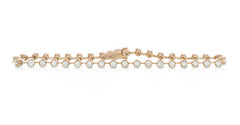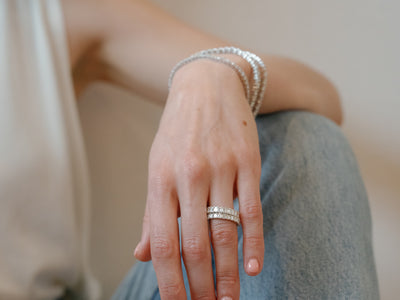Whether you’re in the market for a traditional engagement ring or are looking to have a family heirloom professionally graded, there’s more to a diamond than what meets the eye. Setting a budget for a timeless piece of diamond jewelry is the first step when shopping, but what you may not know is that clarity can make a world of difference to the price itself. Understanding diamond clarity is essential as you learn more about diamonds and narrow in on the diamond jewelry of your dreams.
The 4Cs of Diamonds
Diamonds are graded and valued on four major factors, commonly called the “Four Cs”: cut, color, carat, and clarity. This universal language helps designers and jewelry lovers determine a diamond's rarity and price point. Before you set out to buy diamond drop earrings, stop to learn the vocabulary so you’re prepared.
What is Diamond Clarity?
Diamond clarity refers to the amount (or absence) of inclusions and imperfections in the stone. Many diamonds may look sparkling, clear, or transparent to the untrained eye, but that’s likely not the case. A completely pure diamond is a rare occurrence, as almost all natural diamonds have some number of flaws. To some, the word “flaw” can sound like an issue—but in reality, they’re normal, and diamonds of all clarity can be set into our favorite diamond wedding bands and other jewelry.
Diamond Grading Scale
In order of most to least pure, diamond stone clarity is graded with this GIA Scale for Diamond Clarity worldwide:
- Flawless (FL)
- Internally Flawless (IF)
- Very, Very Slightly Included (VVS1 and VVS2)
- Very Slightly Included (VS1 and VS2)
- Slightly Included (SI1 and SI2)
- Included (I1, I2, and I3)
What is the Average Clarity Grade of a Diamond?
Most diamonds found on the GIA Clarity Scale fall into the VS or SI ratings, meaning they have some inclusions. While the majority of diamonds are given these average gradings, the more flawless stones have a higher value, widening the price scale in the diamond market. But remember—just because diamonds are graded lower doesn’t mean they don’t have a beautiful use within jewelry designs.
Each flaw is unique, letting you know your diamond is one-of-a-kind and often used in diamond identification. There are a few different types of diamond imperfections based on how the diamonds were formed.
Types of Diamond Imperfections
- Needles: miniature rod-shaped structures that spread horizontally
- Pinpoints: tiny dots that are white, black, or grey
- Clouds: a cluster that appears hazy or cloudlike
- Feathers: organic, wispy shapes that resemble a feather
The 5 Ways Diamond Clarity is Graded
Authenticating diamond clarity is more complex than simply looking at a stone. Experts use these five factors to determine a stone’s rating before approving it for jewelry use:
1. Size of the Diamond Imperfections
When discussing diamond stone clarity, the size factor does not refer to the weight or cut of the diamond stone but to the size of each imperfection found within the glittering gemstone. The larger the impurity or blemish, the lower the rating. Since most of these imperfections cannot be seen by the human eye, the stone will need to be graded under magnification to accurately determine the size and clarity.
2. Nature of the Inclusion
The nature of an inclusion refers to its depth, broken down into two characteristics: internal and external. External impurities that remain on the stone’s surface are called blemishes, but internal impurities extending further into the diamond are called inclusions. While both are naturally forming, the deeper inclusions can impact the diamond’s durability, making it unfavored amongst high-end jewelry designers.
3. Number of Diamond Imperfections
The number of imperfections is a simple step in judging diamond clarity—the more impurities and blemishes, the lower the grade overall. But jewelers can’t discount a high number without checking the rest of the factors.
4. Location of Imperfections
When it comes to diamond clarity, where the imperfections lay in the diamond anatomy matters just as much as the size or depth. At certain points in the stone, an inclusion could bounce off the facets, reflecting multiple times throughout the diamond to give it the appearance of even more impurities. If it’s directly under the top part, or table, of a diamond, it’s obviously visible. How a diamond is shaped, cut, or arranged can affect the overall clarity grade because the location can be manipulated.
5. Diamond Inclusion Color
The darker the inclusion color, the lower the grade, as these can be seen more easily than a lighter one. These color differences are often called the “relief,” describing the contrast between the body color and impurity accent colors. When a diamond is the same hue overall, the diamond clarity is higher.
Can You See the Clarity of a Diamond?
Short answer—sometimes! Diamonds with lower gradings in the Slightly Included or Included category tend to have inclusions that are visible to the naked eye, but anything with a higher grade requires a 10X margination in order to spot any imperfections.
If you’ve ever encountered the term “eye clean” diamond when searching for a diamond tennis bracelet, this refers to any diamond that contains imperfections that could never be seen by the human eye. Purchasing designs with these diamonds can be a budget-friendly option that doesn’t sacrifice style.
Finding the Best Diamond Clarity Grade For Your Needs
Whether you’re researching how to select a diamond earring setting or are interested in purchasing diamonds on your own, understanding the grading system is key to investing in the right stone. But when it comes to picking a grade you’re comfortable with, how do you know what the right option is?
In general, you should use the diamond clarity and grading system to help set a budget you’re comfortable with. From there, experienced jewelers can lead you to the stunning and striking diamond jewelry you’re searching for. If you’re shopping online, a trustworthy product description will list the exact grading for each diamond in the setting, whether it be a cushion cut diamond ring or a subtle necklace. Once you understand how professionals grade diamond clarity, you’re ready to explore the world of diamond jewelry.
Sometimes, shopping for jewelry involves more than waltzing into a store and trying on glittering gemstones (though that is always welcome). Discovering the ins and outs of diamond grading can help you make an informed and fashionable choice during your shopping spree. Understanding diamond clarity is the key to buying pieces you’ll love to see shine in for years.









